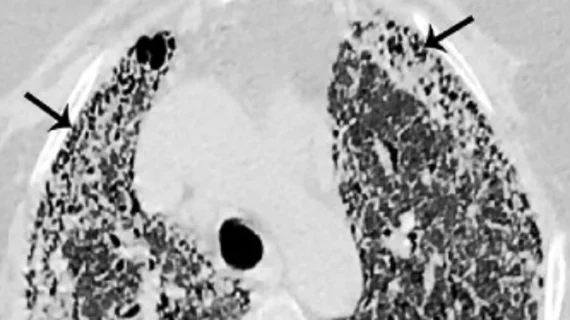Lung disease reporting system improves consistency—so why is it underutilized?
A classification system created to standardize reporting of various interstitial lung diseases (ISD) has proven effective at improving the accuracy of diagnoses, but its use has been largely limited since its development in 2019. New work in the European Journal of Radiology explores the reasons behind this. [1]
The Interstitial Lung Disease Imaging-Reporting and Data System (ILD-RADS) was developed to address issues with inconsistency when reading high resolution CT scans (HRCT) of the lungs in patients with a suspected ILD, especially among less experienced radiologists or general radiologists who are not frequently tasked with differentiating different types of lung diseases. The system includes five categories for reporting HRCT image findings of ILD.
Authors of the new paper conducted their own analysis to assess clinical utility of ILD-RADS by having three radiologists interpret the imaging of 111 patients with confirmed ILDs, having them assign an ILD-RADS category for each patient. Using the classification system, the readers achieved excellent intra-reader agreement. Further, each radiologist gave a positive response when questioned about using ILD-RADS in daily practice.
Previous studies have come to similar conclusions—that ILD-RADS has great clinical potential in diagnosing what is known to be a complex disease. So why isn’t it widely utilized yet?
Although the team observed solid intra-reader agreement, inter-reader agreement varied significantly, highlighting a need to increase the system’s reproducibility, corresponding author of the paper Al Shaimaa Fathi Elshetry, with radiology department at Zagazig Chest Hospital in Egypt, and co-authors noted.
In prior studies on ILD-RADS, readers alluded to a need for additional training on the use of ILD-RADS due to its complexity, acknowledging that using the system required a high degree of experience.
The authors offered a couple of different suggestions to address the issue. First, they suggested the creation of an illustrative HRCT atlas specific to ILDs to be used alongside ILD-RADS for readers to use as as reference. Further, they highlighted a need for additional training specific to the use of ILD-RADS to increase awareness of the system among general radiologists about different HRCT features and patterns in reporting on ILDs.
“We believe that these measures can enhance the analysis of HRCT features, reduce the inherent inconsistency in HRCT reporting of ILDs, particularly among general radiologists, and eventually improve the reproducibility of the ILD-RADS,” the authors suggested, adding that future research on the topic should survey a larger and more diverse group of radiologists to better understand how they perceive the system.

